Unpretentious, universal to use, early ripening tomato “Druzhok f1”: reviews and growing secrets
Several decades ago, the tomato variety Druzhok was popular among beginners and experienced summer residents. However, gradually the popularity of the variety began to decline due to decreased yields and pest attacks. But thanks to breeders, the F1 hybrid appeared on the basis of the variety. Now tomatoes are more resistant to weather changes, protected from diseases and delight with great taste.
Description
Hybrid Druzhok F1 is determinate, medium-sized. The height of the bush does not exceed 50-70 cm. The tops are compact and thick-trunked, which makes them strong.
The first brush from the fruit is formed above the 6th leaf, the rest - after 2-3 leaves. Each bunch produces 6 to 8 tomatoes.
Distinctive features
The peculiarity of the hybrid lies in its unpretentiousness to growing conditions. Due to this, the fruits ripen in any weather. After the tomatoes form on the inflorescence of the main stem, the plant enters the active growth phase. This is not typical for the group determinant tomatoes.
Reference. To increase productivity, bushes are recommended tie up to the support.
When growing tomatoes in greenhouses or tunnels under film without additional heating, the bush forms 2-3 stems. They are obtained from stepsons that grow in the axils of the leaves located under the first inflorescence. Thanks to this, 3-4 inflorescences appear on each stem.
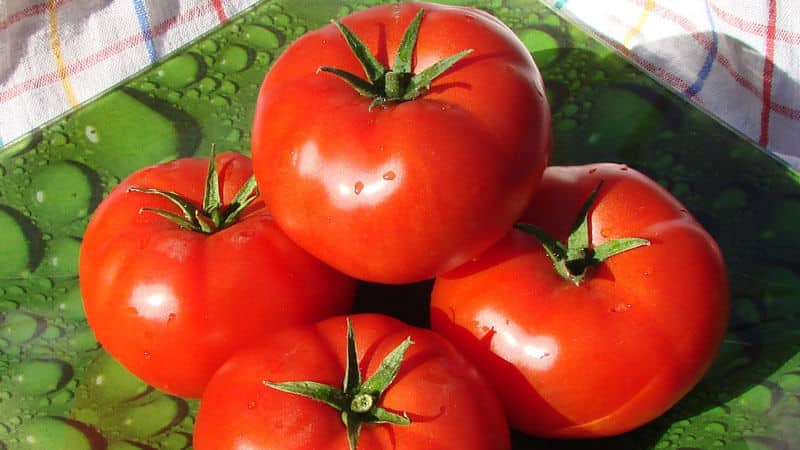
Fruit characteristics and yield
The hybrid variety Druzhok is an early ripening tomato.After germination and before harvesting, an average of 85-90 days pass. The tomato is universal, the fruits ripen almost simultaneously. Tomatoes are harvested in 1-2 times, which is convenient if the main part goes for processing or marketing. Product germination rate is 90%. A view of a ripe Druzhok tomato is shown in the photo above.
High level productivity – 8-10 kg per 1 m². The hybrid is resistant to transportation and long-term storage without loss of external and taste qualities. The variety is unpretentious and can withstand temperature fluctuations and exposure to direct sunlight. The plant responds well to fertilization and watering.
Fruit characteristics:
- Tomato has a distinct red color.
- The shape of the tomato is flat-round.
- Average weight is 110-115 g.
- With improved care, the weight of the fetus reaches 150-200 g.
- The tomato tastes sweet, fleshy, dense.
- The seeds are in 2-4 nests.
- When processed into juice, the dry matter is not less than 5%, sugar - 4%.
Tomatoes are suitable for fresh consumption, canning and processing. The hybrid is characterized by an attractive appearance, therefore it is in particular demand among gardeners and traders.
How to grow seedlings
According to the description on the package, the seeds are sown from April 1 to April 15. If landing is planned at the end of May or beginning of June, the dates are shifted to April 15-30.
Seed preparation
To protect the plant from fungal diseases and increase the percentage of germination, the seeds are treated with a solution of potassium permanganate and water before sowing (1 g of manganese is diluted in 100 ml of water at room temperature).
The result should be a dark liquid with a thick consistency - the key to high-quality disinfection. Seeds placed in it for 25 minutes.If the packaging indicates that the material has already been processed, this step can be skipped.
Attention! Before planting seeds, you need to check their quality - soak for 30 minutes. Floated specimens are not suitable for planting. It is also important to look at the expiration date on the packaging.
Next, the planting material is washed with running water and dried with a paper towel. You can use a growth stimulator. A piece of gauze is moistened in the solution, the seeds are placed in it, placed in a plate or other container and left warm for 24 hours. The following products are suitable for this: “Epin”, “Kornevin”, “Silk”, “Zircon” or sodium humate.
Container and soil
It is recommended to plant seedlings in special containers, which are purchased at agricultural markets or in stores where seeds are sold. You can also make them yourself. The container should be wide, but shallow. Plant seedlings into pots whose volume does not exceed 300 ml. The photo below shows suitable containers.
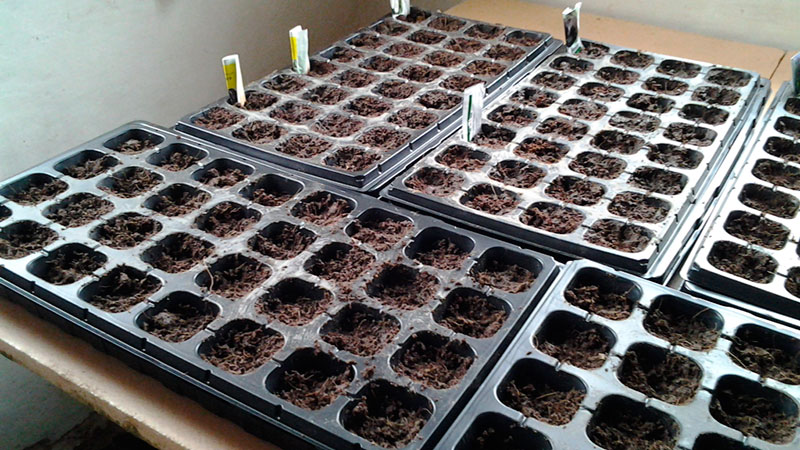
Soil for seeds is made from humus and black soil. To make the composition softer, it is recommended to add additional sand, sawdust, and fine coconut fiber. Additionally, you can include ash and Fitosporin in the composition. If you plan to buy a ready-made mixture, it is better to choose one adapted for tomatoes and peppers.
Advice. Experienced gardeners advise beginners to use soil from a greenhouse so that the tomatoes, after planting in the soil, take root faster and easier.
The soil from the street, even though it is in a covered place, can contain many pests. To get rid of them, disinfection is carried out. To do this, the soil is calcined in the oven, poured with boiling water or doused with an aqueous solution of potassium permanganate. It is enough to wait 30 minutes.
Sowing
After preparing the soil, make holes or grooves in it no more than 1-2 cm deep at a distance of 2 cm from each other. The seeds are placed in the resulting depressions. They are sprinkled with earth on top, but not compacted. It is recommended to moisten the soil with warm water using a spray bottle.
To speed up germination, containers are covered with film or glass. Be sure to place the seedlings in a warm room. Optimal temperature control is within 23-25°C. In such conditions, the seeds will begin to germinate after 3-5 days.
Growing and care
After the first shoots appear, make sure that the temperature during the day is 16-18°C, and at night – no more than 13-15°C. The seedlings remain in this mode until 2-3 true leaves appear (after about 30-35 days). During the entire period, seedlings should be watered 2-3 times so that they do not stretch out during the low light season.
Every day, turn the container with seeds the other side towards the window so that the stems do not tilt. It is not recommended to water seedlings frequently. Make sure that water does not get on the foliage. The seeds are in the boxes without fertilizer. After 2-3 true leaves appear, the seedlings are planted in pots measuring 8x8 cm and left for about 20-25 more.
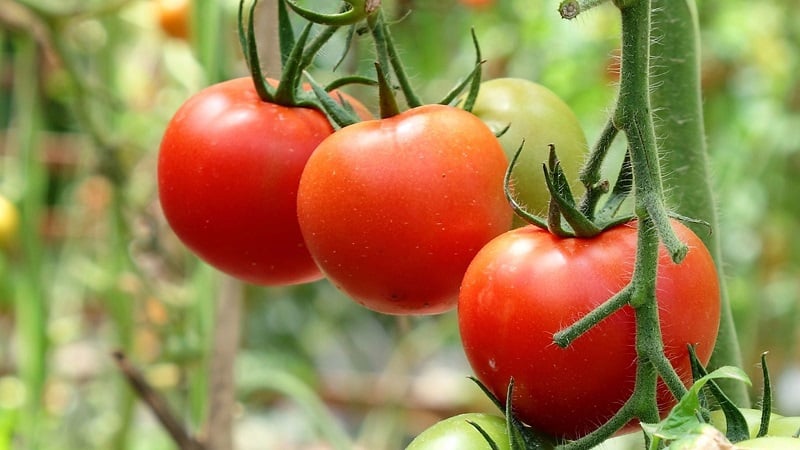
How to grow tomatoes
For the hybrid tomato Druzhok F1, soil is especially important. If it has a high concentration of clay, it is recommended for each square. m of land add 1 bucket of peat, humus or sawdust.
If the composition contains more peat, then humus, turf, sawdust or sand are added.
Landing
It is recommended to plant plants in a permanent place at the age of 30-35 days. Often this period occurs at the end of May or beginning of June, so it is better to place the tomato in greenhouse conditions.
If planting is done directly in open ground, the seeds are sown 2 weeks later than the recommended date. This way you can be sure that the air temperature will be stable at the time of transplantation.
It is recommended to first disinfect the soil with a hot solution of potassium permanganate (1 g of manganese per 10 liters of water). Place the sprouts at a distance of 40-50 cm from each other in one row. Many gardeners advise planting tomatoes in a checkerboard pattern.
Care
To get a good harvest, the Druzhok tomato must be watered correctly and regularly. A ratio of 85-90% soil moisture under the bush and 50% air humidity is considered favorable. After planting in the ground, the seedlings need to be well watered at the root and left for 2-3 days. After this, moisturizing is repeated 1-2 times a week.
Important! During the formation of inflorescences, the plant must receive magnesium.
Fertilizing is done once every 2-3 weeks, and it is important to alternate organic and mineral fertilizers. It is recommended to combine loosening the soil between rows with weeding.
The depth of loosening during the first 2-3 weeks after planting is no more than 12 cm. When the bush grows, additional hilling is carried out (the first - 2-3 weeks after planting, subsequent ones - at intervals of 15 days).
Features of cultivation and possible difficulties
In the review of the Druzhok F1 tomato, it is necessary to touch upon the topic of possible difficulties and characteristics of cultivation.
Experienced agronomists recommend:
- feed young seedlings with liquid fertilizers;
- treat the roots with strengthening solutions before planting in the ground;
- carefully select seeds and seedlings before planting, do not waste time on weak plants;
- use drip irrigation or apply water in doses to each bush;
- soil mulch straw, hay or freshly cut grass.
As for possible difficulties, the Druzhok hybrid is considered an unpretentious variety of tomatoes. If all planting and care rules are followed, you can count on good seed germination and high yield.
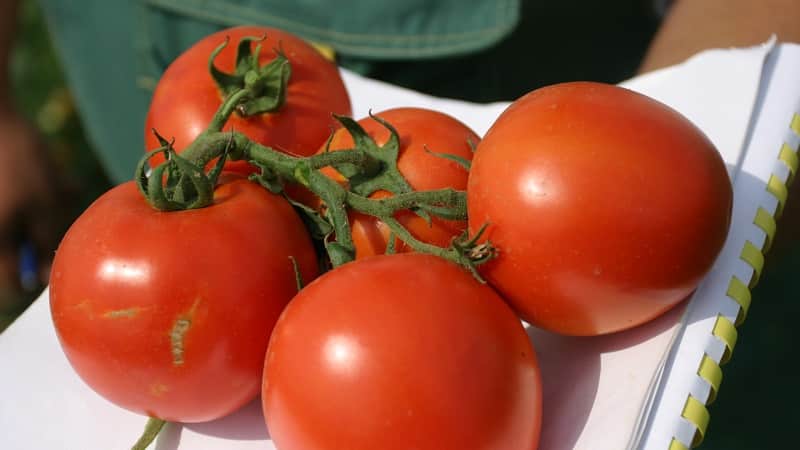
Diseases and pests
The main goal of breeding a hybrid was to save the agronomist from unnecessary hassle. Therefore, a characteristic feature of Druzhka is its high resistance to diseases and pests.
The stem and leaves contain a large amount of alkaloids that repel natural enemies of the nightshade family.
As a preventative measure, it is recommended to regularly inspect the bushes. Additionally, spraying with a solution of laundry soap (dilute 1 tbsp. grated product per 10 liters of water) will protect the plants.
The nuances of growing in open ground and in a greenhouse
The hybrid is classified as determinant, so its growth stops after the formation of 3-4 inflorescences. If tomatoes are grown in a greenhouse, it is better to form one stem.
Reference. When forming the hybrid Druzhok F1 into one stem, it is allowed to increase the planting density by 25-30%.
After 3-4 inflorescences appear, it is necessary to pinch the growing point. Every stepson pinch after the formation of 3-4 brushes. Thanks to this, all the energy will be spent on the formation and growth of the fruits of the main stem. Shoots are removed until they reach the top of the greenhouse or maximum growth.
If the tomato is planted directly in open ground, then it is better to form 3 stems. This is done according to the above scheme (growth points are pinched).To make the side stems powerful, stepsons of leaves are left under the first inflorescence. As a result of these actions, a bush up to 1 m high with 3-4 inflorescences on each stem is obtained.
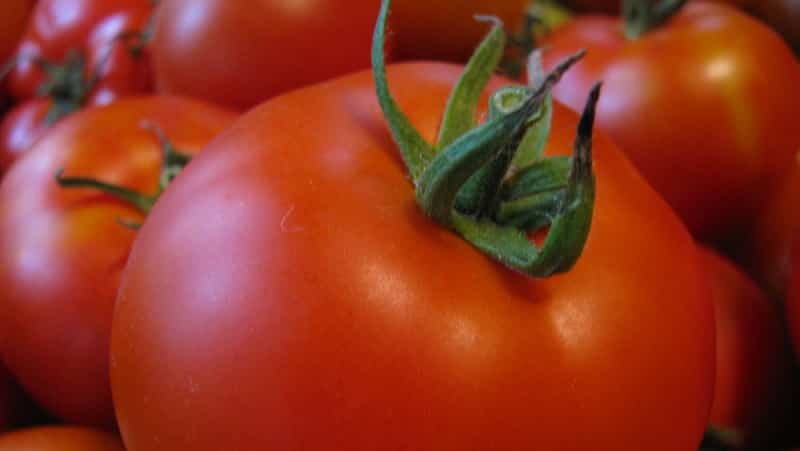
Harvesting and application
The harvest is harvested 85-90 days after the first shoots in one or two times.
Tomato Druzhok F1 is universally used, suitable for eating raw, adding to dishes, preserving and other processing.
Advantages and disadvantages of the variety
Among the advantages of the hybrid are:
- rapid ripening;
- high productivity;
- possibility of planting in unheated greenhouses;
- good taste;
- versatility of use;
- good presentation.
Among the disadvantages, gardeners note only the need to tie up the plant, which takes a lot of time.
Farmer reviews
Reviews from professional and novice gardeners about the Druzhok F1 tomato are mostly positive.
Elena, Krasnodar: “Last year I planted this hybrid for the first time. I'm happy with the result, but initially I needed to get acquainted with the intricacies of stem formation. Now I’ll think in advance about the best place to plant tomatoes and prepare places for tying them up. The only thing that upsets me is the impossibility of preparing seeds on my own.”
Olga, Voronezh: “I grew this tomato in pots that are in my gazebo. After the formation of three stems, I noticed that the bush turned out to be very spreading, and at the same time it looked quite nice. The tomatoes are delicious, even small children liked them. This year I will plant again and recommend it to everyone.”
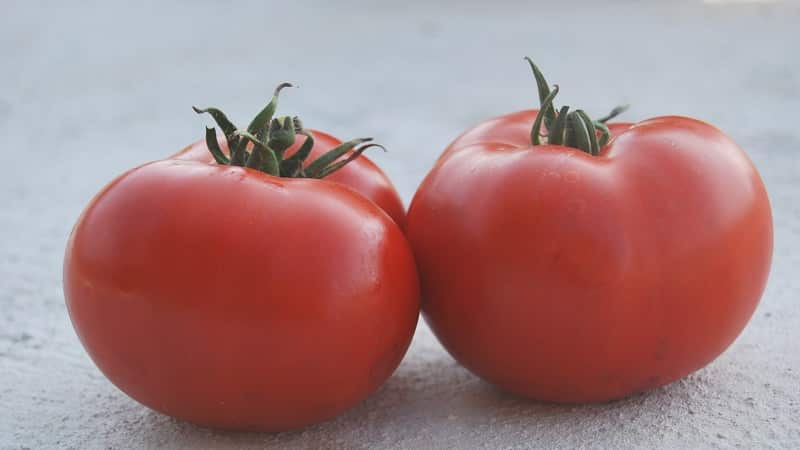
Conclusion
The hybrid tomato Druzhok F1 will provide a large family with tasty and fleshy fruits in one season, and the harvest will also be enough for sale.Unpretentious in care, resistant to temperature changes, diseases and pests, the tomato will allow the agronomist to devote more time to other concerns.